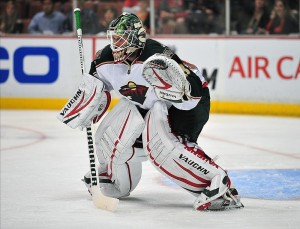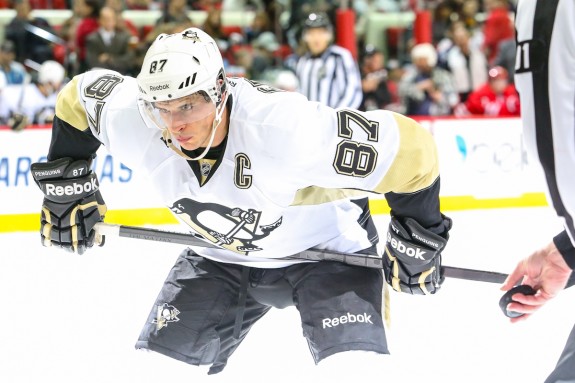
Goalies receive chaperoned protection by the NHL referees. There is no problem with coddling goalies since they are the most defenseless individuals on the ice. They’d be mauled if the majority of the plays didn’t end in a whistle on their behalf. But the mentality to overprotect goalies any time they are contacted has been taken to an extreme.
Protecting goalies has its limits. Just because a player collides or makes contact with a goalie doesn’t mean this should automatically result in a two-minute minor penalty. But this seems to be the rule in all cases. Every time an opposing player makes contact with a goalie, this seems to result in a penalty whether the act was worthy of one or not. This past week, there were a few instances that had me wondering if goalies were being pampered too much.
Are Goalies Overprotected?
Last Wednesday, the Pittsburgh Penguins played the New York Rangers to a 3-3 tie by the end of regulation. On the first shift of the overtime period, Chris Kunitz took a pass near the right half-wall and drove to the net on Henrik Lundqvist. Kunitz had a violent collision with Lundqvist and was awarded a two minute penalty for interference on a goalkeeper.
Rule 69 – Interference on the Goalkeeper
Lundqvist was outside of his goal crease when he made the save. With Lundqvist sliding towards an oncoming Kunitz, there was no time and space for Kunitz to avoid contact. If you watched the game, you know that Kunitz attempted to avoid a collision with Lundqvist. Kunitz tried to slide out of the way, but there was no hope as Lundqvist slid directly into Kunitz’s path. A violent wreck was inevitable in this case. Despite the attempt made by Kunitz to avoid contact, referee Steve Kozari immediately pointed towards the penalty box. This was all based upon the severity of the collision. Kozari didn’t even take a moment to evaluate what took place. His mind was made up to protect Lundqvist no matter what the cost. This penalty was in overtime and nearly cost the Penguins a victory. This wasn’t the only questionable incident. A day later the Penguins played the Minnesota Wild and Sidney Crosby was called for goalie interference. Keith Ballard cross-checked Crosby into Wild net-minder Niklas Backstrom. Crosby wasn’t trying to be dirty and make it look as if he accidentally tumbled into Backstrom. Ballard made Crosby lose his balance. Crosby had nowhere to land but on top of Backstrom. With the help of some major embellishment on Backstrom’s part, again a penalty was handed out when the referee’s arm should have stayed down.

“I was trying to avoid him,” said Crosby. “I knew where he (Backstrom) was and I was trying to stay outside the crease and got pushed onto him. It’s a tough one to make as far as the ref is concerned. It’s hard to see if whether I was trying to avoid him, but I was. Unfortunately I got a penalty there.” There are many occurrences of questionable goalie interference calls every season. The subject is a very gray matter, but the referees must do a better job. It doesn’t take special eye sight for someone to realize that Ballard’s cross-check was the reason why Crosby fell onto Backstrom. In this era, it feels like all goalies have to do is search for contact to draw a penalty. The goaltenders are also becoming more adept at diving or embellishing in order to tempt the referee to make a penalty call. These issues need to be analyzed more during the game instead of jumping to conclusions. Referees are too quickly siding with the goaltenders. Don’t get me wrong, goalies should be protected, but in an appropriate manner. The referees got the two calls against Crosby and Kunitz wrong. There are many examples where the wrong call has been made against other teams as well. The question remains whether the league office sided with the two refs who made these terrible calls. Looking at past penalties called for goalie interference, it’s highly unlikely. While goalies deserve protection, hockey is a contact sport. The league needs to make sure the correct calls are made or a referee’s mistake may cost a team an important game. Follow @JTGlock
Firstly, I don’t think the video of the collision with Lunquist was a good example to support your case. His right foot was still in the crease when he was run into (so technically by the rules, he was in the crease). Secondly, he was in the process of making the save, shifting to his left to track the penguins player as he drove the net. He wasn’t that far on the edge of his crease to play a loose puck or throw a pick on a forechecker. He was making the save. He also is totally puck focused with little chance to avoid a collision or, more importantly, protect or brace himself.
I think the main impetus of the increased vigilance for goalie interference calls is to prevent tit-for-tat goalie-running that used to happen. In earlier years, a goalie getting run usually lead to fisticuffs (something the league wants to minimize) and I think calling penalties on this have helped cut back in post-whistle scrums. Or worse, it lead the offended team to go up the ice on the next attack and plow the opposition’s goaltender.
Also, running goalies have a major impact on games and series. Careers were also ended and play-off series lost because a goalie was run (see Grant Fuhr’s St. Louis’ play-off run). When the difference between two teams is the quality of each team’s goaltender, the quick and easy solution was to take the stronger goalie out of the equation. With instigator penalties being enforced, it is hard for a team to “protect” their meal-ticket.
You may be interested in the new rules that Hockey Canada have set up for goalie interference penalties at the tier-II junior level (junior A, in Canada). The second team, not individual, goalie interference penalty leads to a game misconduct and a one game suspension of the player. The third goalie interference penalty on a team, leads to a 3-game suspension, a game suspension of the coach, and a fine for the team.
If goalies are selling the dives to draw goalie interference penalties, it will only be a matter of time when the refs start calling diving penalties on the goalies. And this rule is written clearly and highlights the scenario of goaltenders diving in the NHL rulebook. (rule 64.1)
Obvious pengoons homerism. Disregard.
I do cover the Penguins and see all of their games so yes I used them as an example. But go type in “goalie interference 2013” on YouTube. The first four videos (not of the Pens) are all questionable calls. Then you’ll see my point. The Pens are irrelevant in the matter, but thanks for reading.